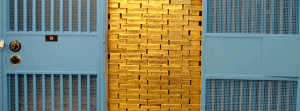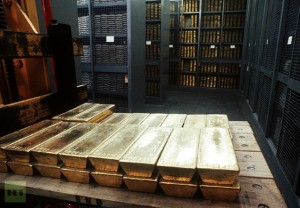Central Banking with “Other People’s Gold”: A Multi-billion Treasure Trove in Lower Manhattan
ANGLO AMERICA, CAPITALISM, ECONOMICS, 13 May 2013
Prof Michel Chossudovsky – Global Research
Germany is repatriating its gold reserves from the New York Federal Reserve. This decision has created a frenzy in the gold market. But that is just the tip of the iceberg.
According to the NY Fed, there are (2012) approximately 530,000 gold bars, with a combined weight of circa 6,700 metric tonnes stashed away in the Fed’s Lower Manhattan vaults.
These are official figures which are impossible to verify.
The gold is stored in the fifth sub-floor of the New York Fed building on Liberty Street. The vaults on the bedrock of Manhattan Island are located 80 feet below street level.
Each of the 530,000 gold bars weighs 400 troy ounces, or about 12.44kg.
At today’s market value of approximately US$1700 dollars a troy ounce, the New York Fed has within its vaults a multi-billion dollar treasure trove.
The 400-ounce gold bar is quoted at $677,640.
A 1kg gold bar is quoted at about $55,000. (purchase price)
Each metric tonne of gold is worth approximately $55 million.
The total value of the New York Federal Reserve’s gold bullion trove of 6700 tonnes is a staggering $368.5 billion.
But according to the New York Federal Reserve: “We do not own the gold. We are mere custodians.”

A wall of gold bricks in the globally owned collection at the Federal Reserve Bank of New York. (Photo courtesy of the New York Fed’s press center)
The gold is in “safe-keeping” on behalf of more than 60 sovereign countries and a few organizations. Close to 98 per cent of the gold bullion stored in the NY Fed’s lower Manhattan vaults, according to the Fed, belongs to central banks of foreign countries.
The remaining 2 per cent “is owned by the United States and international organizations such as the IMF.”
Germany’s central bank owns a total of 3400 tonnes of gold. According to recent reports, a staggering 69 per cent of its gold bullion bars (namely 2346 tonnes) are held in custody at the New York Federal Reserve, the Bank of England and the Banque de France.
The NY Federal Reserve Bank holds in custody 1536 metric tonnes of gold owned by the Bundesbank of the Federal Republic of Germany, 22.9 per cent of its total gold holdings in custody (6700 tonnes).
The Bundesbank has announced that it will repatriate “all of its 374 metric tonnes stored at the Banque de France (11 per cent of its total reserves), and 300 metric tonnes held in the vault of the New York Fed, reducing its share in the US from 45 per cent to 37 per cent.” .
Two other European countries, namely Italy and the Netherlands, have significant yet undisclosed gold bullion reserves held in custody in the vaults of the NY Federal Reserve Bank. There are no immediate plans to repatriate this bullion.
While the NY Federal Reserve Bank does not actually own the gold, it is guardian of a multibillion-dollar gold treasure, which indelibly provides ‘collateral’ (at virtually no cost) as well as ‘leverage’ in its multibillion-dollar central banking operations, often at the expense of its European partners.
The New York Fed’s gold vault on the basement floor of its main office building in Manhattan provides account holders with a secure location to store their monetary gold reserves.
None of the gold stored in the vault belongs to the New York Fed or the Federal Reserve System. The New York Fed acts as the guardian and custodian of the gold riches on behalf of account holders, which include the US government, foreign governments, other central banks and official international organizations.
In other words, the Fed runs its operation ‘with other people’s gold’, using this huge treasure as ‘collateral’ to back its various financial undertakings.
Foreign countries around the world were pressured after World War II into depositing their gold reserves, not within the vaults of their own central banks, but in that of the world’s foremost imperial power.
According to the NY Federal Reserve:
“Much of the gold in the vault arrived during and after World War II as many countries wanted to store their gold reserves in a safe location. Holdings in the gold vault continued to increase and peaked in 1973, shortly after the United States suspended convertibility of dollars into gold for foreign governments.” (emphasis added)
For many countries, part of the US dollar proceeds of commodities sold to the US, were converted into gold at 32 dollars an ounce (1946-71) and then ‘returned’ – so to speak – to the US for deposit in the vaults of the NY Federal Reserve.
Germany’s decision to repatriate part of its gold has sent a cold shiver into the gold and forex markets.
The German Federal Court of Auditors has recently called for an official inspection of German gold reserves stored at the New York Federal Reserve, “because they have never been fully checked.”
Are these German bullion reserves held in the vaults of Lower Manhattan ‘separate’ or are they part of the Federal Reserve’s fungible ‘big pot’ of gold assets.
According to the Fed, “the gold is not commingled between account holders.”
Does the New York Federal Reserve Bank have “Fungible Gold Assets to the Degree Claimed”?
Could the Fed reasonably handle a process of homeland repatriation of gold assets initiated by several countries simultaneously?
According to the Fed, there are 122 separate gold accounts mainly held by the central banks of foreign countries, as well as a few organizations including the International Monetary Fund.
Following the verification process, the gold is moved to one of the vault’s 122 compartments, where each compartment contains gold held by a single account holder. In rare cases, small deposits are placed on separately numbered spaces on shelves in a ‘library’ compartment shared by several account holders. Each compartment is secured by a padlock, two combination locks and an auditor’s seal. Compartments are numbered rather than named to maintain confidentiality of the account holders.
The New York Fed does not indicate in any of its reports, including its annual financial statements, the names of the countries and account holders.
Most of the 122 accounts are held by the central banks of sovereign countries, which in addition to their gold accounts have statutory agreements with the NY Federal Reserve.
Money and National sovereignty
America’s Unipolar World hinges on sustaining the US dollar as a global reserve currency. US hegemony in monetary matters is supported by the custody in the USA of gold bullion reserves on behalf of more than 60 countries.
Instead of gold bullion, national central banks (with the exception of the US) hold US dollar paper instruments as ‘reserves’. Gold reserves under national jurisdiction are central to establishing sovereignty in monetary policy, without depending on the Federal Reserve which holds a nation’s gold bullion in safe-keeping in its Lower Manhattan vault.
National sovereignty requires the repatriation of the gold bullion deposited in custody with the NY Fed. The leverage and collateral in all monetary transactions largely accrues to the NY Federal Reserve Bank rather than to the owners of the bullion deposited in custody.
Follow the example of Germany. Repatriate your gold.
In a related development, both China and Russia are dumping their US dollars and building up their gold reserves.
In turn, both China and Russia have boosted domestic production of gold, a large share of which is being purchased by their central banks.
__________________________
Michel Chossudovsky is an award-winning author, Professor of Economics (emeritus) at the University of Ottawa, Founder and Director of the Centre for Research on Globalization (CRG), Montreal and Editor of the globalresearch.ca website. He is the author of The Globalization of Poverty and The New World Order (2003) and America’s “War on Terrorism”(2005). His most recent book is entitled Towards a World War III Scenario: The Dangers of Nuclear War (2011).
Go to Original – globalresearch.ca
DISCLAIMER: The statements, views and opinions expressed in pieces republished here are solely those of the authors and do not necessarily represent those of TMS. In accordance with title 17 U.S.C. section 107, this material is distributed without profit to those who have expressed a prior interest in receiving the included information for research and educational purposes. TMS has no affiliation whatsoever with the originator of this article nor is TMS endorsed or sponsored by the originator. “GO TO ORIGINAL” links are provided as a convenience to our readers and allow for verification of authenticity. However, as originating pages are often updated by their originating host sites, the versions posted may not match the versions our readers view when clicking the “GO TO ORIGINAL” links. This site contains copyrighted material the use of which has not always been specifically authorized by the copyright owner. We are making such material available in our efforts to advance understanding of environmental, political, human rights, economic, democracy, scientific, and social justice issues, etc. We believe this constitutes a ‘fair use’ of any such copyrighted material as provided for in section 107 of the US Copyright Law. In accordance with Title 17 U.S.C. Section 107, the material on this site is distributed without profit to those who have expressed a prior interest in receiving the included information for research and educational purposes. For more information go to: http://www.law.cornell.edu/uscode/17/107.shtml. If you wish to use copyrighted material from this site for purposes of your own that go beyond ‘fair use’, you must obtain permission from the copyright owner.
Read more
Click here to go to the current weekly digest or pick another article:
ANGLO AMERICA:
- ‘We Want It Back’: Trump Asserts U.S. Claims to Venezuelan Oil and Land
- Judge, Jury, and Executioner: On U.S. Assassination Policy 1975-2025
- Everything the Trump Administration Is Doing in Venezuela Involves Oil and Regime Change—Even if the White House Won’t Admit It
CAPITALISM:
- ‘They’re Trying to Get Rich Off It’: US Contractors Vie to Rebuild Gaza with ‘Alligator Alcatraz’ Team in the Lead
- Don’t Worry, Be Happy--All Those Who Feared a Capitalist Dystopian Future Got It Wrong
- The Earth Is Unhappy with the Capitalist Climate Catastrophe
ECONOMICS:
